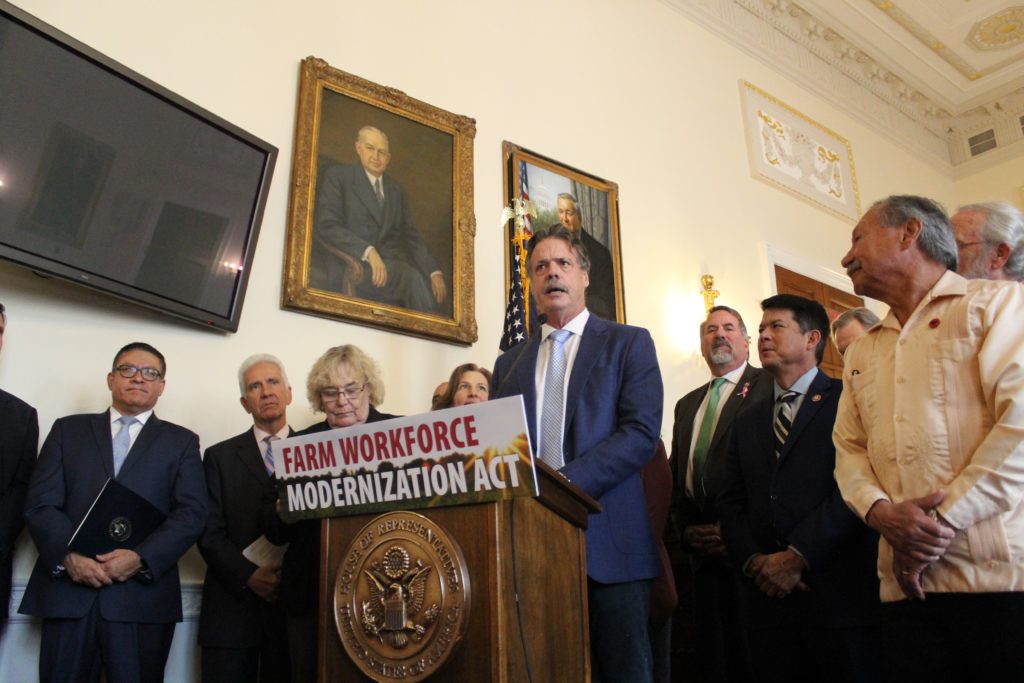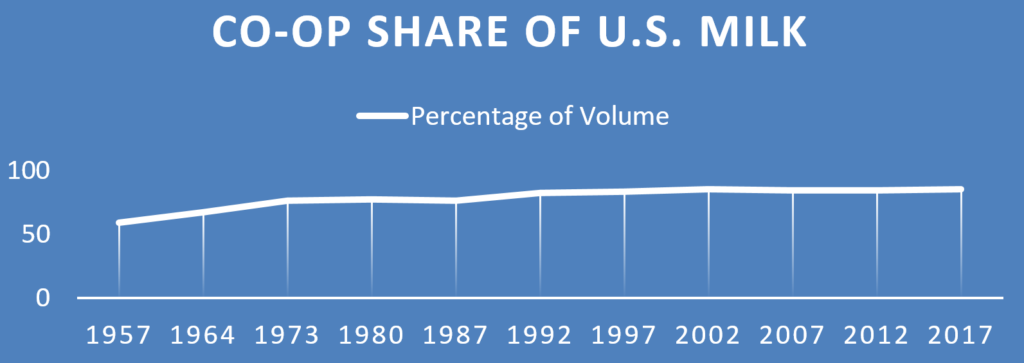This month’s CEO’s Corner comes from NMPF President and CEO Jim Mulhern’s remarks at the National Milk Producers Federation annual meeting in New Orleans, delivered Nov. 6. Remarks condensed from full address.
As I was putting my thoughts together for this year’s meeting, I was walking through the office a couple weeks ago and I saw a sign in one of my staff members’ offices. I’ve seen this sign hundreds of times, but as I was thinking of this meeting it struck me anew. The sign has a word on it, and the word is resilience. I think that one word really captures what this industry is all about, what you are all about and it’s what I want to briefly focus on this morning.
It’s an understatement to say we’ve been in tough times these last five years, and your resilience in the face of the economic challenges that we’ve been dealing with has been remarkable. And it’s driven all of us who work for you to work that much harder to support you and advance your agenda, whether it’s in Washington on the policy front or on the promotion front across this country — and really around the world.
It has been a tough time. A year ago we were in our fourth straight year of low prices, and Congress hadn’t passed the farm bill. Today it’s a different situation. Prices are improving. We’ve got the Dairy Margin Coverage program in place, providing more than $300 million in assistance this year, assistance that wouldn’t have happened without that program, without the hard work of all of you and the folks you represent around the country.
And it isn’t just that safety net. It’s also provisions in the program for better risk management for larger producers– getting a revenue protection program in place, getting LGM (Livestock Gross Margin program) caps lifted. We’ve got better tools to deal with the vagaries of the market and as we go into the future, that’s really going to help us. We all know that dairy farming can be challenging, even in the best of times, and these certainly haven’t been the best of times, but they’re getting better. Improved prices that we’re seeing, and a better safety net and improved risk management, will encourage a more resilient dairy industry in the months and years ahead.
It’d like to talk about just a couple issues. Trade has been an area where we’ve had to be especially resilient, given the challenges we’ve faced these last few years. We know our future is heavily dependent on our ability to access the international market and gain access to that market. We produce 30 billion pounds more milk today than we consume in the United States. Domestic demand is strong, but you guys are stronger in your ability to produce milk, so we’ve got to look to those export markets to grow this industry and grow opportunity for the future. We’ve got an incredible leader, as you just saw this morning and as I get to see on a daily basis, an incredible leader in Secretary Tom Vilsack, working on your behalf at the U.S. Dairy Export Council, providing tremendous guidance not only on exports, but even broader issues, such as sustainability, and giving greater visibility to the work of this industry, all to help advance our interests.
The picture a year ago was not a pretty one.
We had cheese exports to Mexico hit by tariffs. Virtually all our products going to China, hit by tariffs. The European Union, busily negotiating bilateral agreements with important markets to us like Mexico and Japan. Big challenges on many fronts. USMCA was approved, but still not done through the Congress yet.
These challenges have threatened to derail our efforts to grow exports, but we’ve been at the fight every step of the way pursuing our global strategy, and we have made great progress in the last year.
The USMCA agreement does protect our access to our number-one market, Mexico. The agreement has hard-fought disciplines on Canada. We’ve got a down payment agreement with Japan. We didn’t get everything we wanted, but secured important access, to U.S. cheese in particular. There is more work to be done, we’re going to keep at it, but it was an important gain.
Another issue: Airbus. It has nothing to do with the dairy industry directly — but it’s part of the continual effort of the European Union to deploy trade policy to protect their domestic industries, blocking our products out. We fought hard to make sure that given the EU practices on the Airbus issues, and the WTO approval of the United States’ ability to put retaliatory tariffs in place, we wanted to make sure dairy was high on that retaliation list — not because cheese has much to do with airplanes, but because we wanted to send a message to the Europeans that the way you play the game is not acceptable. If you’re not going to give us access to your market, you don’t deserve unfettered access that lets you sell about $1.5 billion worth of cheese to the United States while we are blocked from selling much more than about $150 million total dairy product into the EU because of these barriers.
It also sends a message on common food names. The Italian president was in the White House about two weeks ago, complaining to the president about how those retaliatory tariffs the United States put on the EU were going to increase the price of Italian cheeses and that wasn’t fair. We reminded the president the next day that what wasn’t really fair was what I just talked about — the Europeans blocking access for us to that market and their efforts to take away common food names that are important for our future growth in the cheese market around the world.
Finally, we’ve been busy with Cooperatives Working Together, working to expand export sales. That program is so important — when you have a situation which we face most of the time, where world prices are below our domestic market prices for key products, cheese in particular, but also butter and whole milk powder. We use CWT to provide needed assistance, to get that product into the world market. So far this year, the CWT exports that we’ve sent into the world market have covered more than twice the increase in milk production that’s occurred in the United States. That’s helping to improve the supply/demand balance and giving lift to milk prices.
All this has been important. But it’s important to recognize that in this trade environment turbulence likely will be the new normal. We need to be prepared for that. That’s the future we’re going to face, but gains are possible for this industry when we work together, and it’s a tribute to the collaborative effort of these organizations, of USDEC and DMI, on program after program, whether it’s the direct work of USDEC in terms of improving market access, or the market promotion all over the world formed in partnership with companies like Domino’s and many others trying to move our production to the world market. It is the effort of CWT to provide some assistance to get those exports out. It’s the effort of National Milk Producers Federation, working hand in glove with USDEC on trade policy. Together we’re able to get a great deal done on your behalf.
I’m going to spend a couple minutes talking about a topic important to me and very important to you and that’s fake milk — and it gets a little into fake news as well.
When you feel under attack and facing tough time as we’ve certainly been experiencing, it’s easy for your opponents and those who don’t have your best interest at heart, it’s easier for them to try to take control of the narrative. Tom Gallagher did a great job yesterday, talking about the attack on our industry, the attacks on the checkoff program.
As an industry, we see these attacks virtually every single day. Fewer farms since we’ve had tough times economically, the decline in fluid milk sales, growth in alternative dairy products — all of that is spun into a narrative that’s called the “death of dairy.”
We’ve also seen the stories about animal agriculture, not just dairy, means that cows are killing the planet. That’s what our well-funded critics want the public to believe. The reality, as you know, is just the opposite. Rather than an industry in decline, this is a growing sector with very bright days ahead. And that’s what we’ve got to keep in mind. We’ve been through tough times. It’s getting better now. This is an industry with an incredibly powerful future because we produce a food with unparalleled nutrition and great taste.
Central to our story of resilience is getting out the facts. The science and the true narrative about milk. You know those facts. For all the talk about the death of dairy and the decline in fluid milk consumption, the real story is that dairy consumption is at a 56-year high — the highest per capita consumption for dairy since 1962. That’s not the story that the vegan activist, the animal rights activists, want people to hear, but that’s why we need to be talking about it.
Milk is the number one source of nine nutrients in children, and it would be the number one source in the diets of everybody if adults consumed as much milk as would be good for them. That’s a part of our challenge, but those are important facts. There are a lot more on our side. We are winning in facts and we’re beginning to win on opinion on the fake milk issue, and we’re going to keep using these facts, that science, your support, to keep the pressure on the FDA to get action on this issue in 2020.
And finally, you’re going to hear a very positive story from Dr. Frank Mitloehner later this morning on dairy and agriculture — the sustainability story. We are able to tell this story because there is so much going on in this industry on sustainability. We’ve been the leaders. I’ve been privileged to have been engaged in our sustainability efforts for many years. We have more to do on the farm and in telling our story, but we all know that we can do it.
As we look ahead to 2020, we know that dairy has always been a cyclical industry. Our industry prices have been rising this fall, and we have reason to believe that 2020 will be a good year. But that doesn’t mean that there won’t be problems. There will be. But whatever they are, we’ve survived the worst. We know that, and we’re stronger today than we were a year ago.
Resilience against hardship has always been a fact of life in dairy. I’ve seen that resilience over the years, and it has always impressed me so much, and made me proud to work on your behalf.
It’s how we react to hardship that determines the outcome. The onus is on us. We see the signs of change all around us. Yes, this pace of change pushes us out of our comfort zone, and it can be scary. But we know that if we embrace change and hold true to our values, we will win out.
It’s the unity we forge on issues confronting us that will get us through. Whether it’s the longstanding bread-and-butter issues that impact our milk checks, or the new and emerging issues in the consumer marketplace, whether it’s animal care or climate change, or others, our resilience will inform all that we do in the next year, a year that will undoubtedly bring new challenges, but also undoubtedly will bring progress for all of us. I’m ready for it. I hope you are too. Let’s get after it. Thanks very much.









